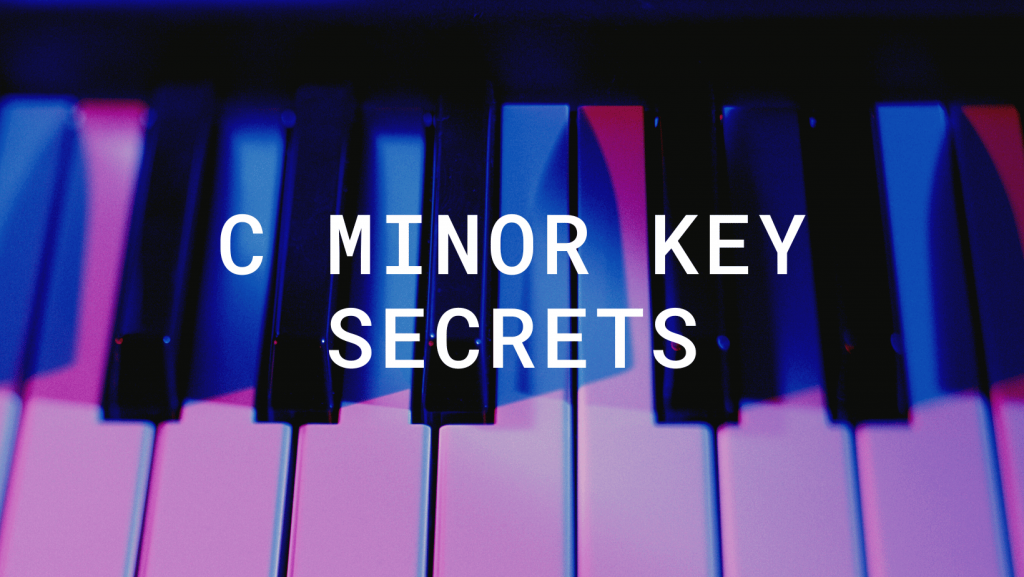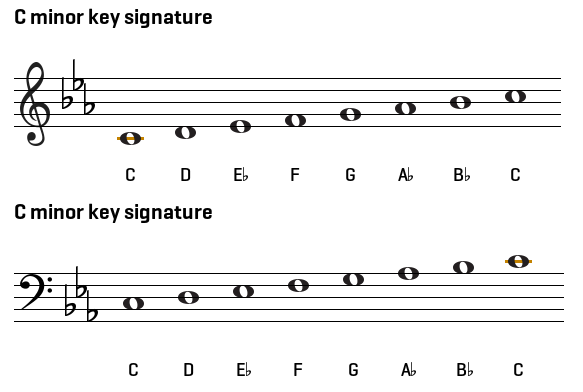
C Minor Key Signature Secrets
- General Music Theory
- 14 February 2023
- 19 h 13 min
C Minor Key Signature Secrets
C minor is one of the most popular key signatures used in music. It is used in many genres of music, from jazz to classical and beyond. In this blog post, we will explore the basics of the C minor key signature, the notes and chords associated with it, and tips for using it in your own compositions. So let’s get started!
Table of Contents
What is the C Minor Key Signature?
The C minor key signature is a set of seven notes and chords that all revolve around the note of C. This key signature is based on the natural minor scale and is one of the most commonly used key signatures in modern music. It is a great accompaniment to a variety of musical styles.
The C minor key signature is based on the natural minor scale, a seven-note scale that contains C, D, E♭, F, G, A♭, and B♭. This scale is sometimes referred to as the “Aeolian” mode.

Relative Major/Minor
The C minor key signature is often referred to as the “relative minor” key signature to E♭ major. The two keys share the same notes, but the C minor key signature contains an extra minor third interval. This interval gives the key signature its unique sound.
Every major key has a relative minor and every minor key has a relative major. For major keys, the relative minor is the sixth scale degree. For minor keys, the relative major is the third scale degree. In the key of C minor, E♭ is the third scale degree (C – D – E♭), so E♭ is the relative major. Simple, right?
The Notes in the C Minor Key Signature
The notes in the C minor key signature are C, D, E♭, F, G, A♭, and B♭. These notes are all derived from the natural minor scale, and they form the basis of the key signature. When playing music in the key of C minor, these notes should be used as a starting point, and other notes can be added as needed.
The C minor key signature has a distinct sound, and is often used to create a melancholic or somber mood. The notes of the key signature are often used in combination with each other, and can be used to create chord progressions that have an emotional impact.

Chords in the C Minor Key Signature
The chords in the C minor key signature are derived from the notes of the key signature. These chords are often used in combination with each other to create chord progressions that have an emotional impact. The chords in the key of C minor are: C minor, D diminished, E♭ major, F minor, G minor, A♭ major, and B♭ major.
These chords can be used in a variety of ways, and are often used to create emotional pieces of music. The chords can be used in both major and minor keys, and can be used to create a wide range of different sounds and moods.
The C minor key signature has a distinct sound, and is often used to create a melancholic or somber mood. The notes of the key signature are often used in combination with each other, and can be used to create chord progressions that have an emotional impact.
How to Use Chords in the Key of C Minor
Chords in the key of C minor can be used in a variety of ways. They can be used in major or minor keys, and can be used to create a wide range of different sounds and moods. One of the most common uses of the chords in the key of C minor is to create chord progressions. Chord progressions can be used to create both uplifting and somber pieces of music.
The chords in the key of C minor can also be used to create melodies. The notes of the key signature can be used to create melodies that have an emotional impact. Melodies in the key of C minor can be used to create a wide range of different sounds and moods.
When using chords in the key of C minor, it’s important to consider their function within a piece of music. For example, the tonic chord (C minor) can be used to establish a sense of home or stability, while the dominant chord (G major) can create a sense of tension and lead the listener back to the tonic. The subdominant chord (F minor) can be used to create a melancholic or introspective mood.
In addition to chord progressions, chords in the key of C minor can also be used for harmonic embellishment. By adding extra chords or substituting chords from outside the key, you can create more complex and interesting harmonic textures.
Another way to use chords in C minor is to create harmonic rhythm. By changing the chords at regular intervals, you can create a sense of motion and development in your music.
Overall, the chords in the key of C minor offer a wide range of possibilities for creating different moods and textures in your music. It’s up to you to experiment and find the combinations that work best for your musical vision.
Popular Songs in the Key of C Minor
Many popular songs are written in the key of C minor. Some of these songs include: “Hotel California” by The Eagles, “Smells Like Teen Spirit” by Nirvana, “Crazy” by Gnarls Barkley, “Clocks” by Coldplay, and “Comfortably Numb” by Pink Floyd. These songs all have a distinct sound, and they all use the chords in the key of C minor to create emotional pieces of music.
Let’s dive into some more examples of songs in the key of C minor in popular music, peeking at the function of the tonality as well:
- “All I Want” by Kodaline uses the key of C minor to create a sense of yearning and longing. The song builds tension with a repeated four-chord progression before releasing into the chorus with a brighter major chord.
- “Someone Like You” by Adele is a powerful ballad that uses C minor to convey the pain and sadness of lost love. The key gives Adele’s voice a haunting quality that adds to the emotion of the lyrics.
- “Hello” by Evanescence is a haunting piano ballad that makes great use of C minor. The song builds slowly, adding layers of instrumentation and vocals to create a sense of intensity and drama.
- “The Scientist” by Coldplay is a classic song that makes great use of C minor to create a feeling of introspection and melancholy. The song builds to a powerful chorus with a soaring melody that adds to the emotional impact.
By studying the use of C minor in these songs, you can learn how to use the key to add depth and emotion to your own compositions. Experiment with different chord progressions and voicings to find the sound that works best for your style.
Popular Chord Progressions in C minor
Some examples of popular chord progression in C minor include:
- C minor – A♭ major – G major – C minor
This progression is a great example of how tension and release can be used to create an emotional impact in music. The A♭ major and G major chords provide a sense of tension that is ultimately resolved by returning to the C minor chord, creating a powerful moment that can be used to great effect in a variety of musical styles.
- C minor – F minor – G major – C minor
This progression is a classic example of a minor key progression that uses the flat VI and flat VII chords to create a sense of tension and release. The F minor chord adds a melancholic quality to the progression, while the G major chord provides a bright and uplifting contrast before resolving back to the C minor chord. This progression has been used in many popular songs and is a great tool for creating an emotional impact in your music.
- C minor – E♭ major – D minor – E♭ major
This chord progression showcases the contrast between the C minor and E♭ major chords, providing a sense of depth and emotion. The D minor chord creates a somber atmosphere that creates a feeling of resolution when returning to the E♭ major chord. This progression is often used to evoke a sense of nostalgia or introspection, making it a powerful tool in creating a unique and emotional sound in your own songs.
- C minor – B♭ major – C minor
This classic progression is a great way to add interest and complexity to a song in a minor key. The use of the B♭ major chord adds a layer of complexity, making the return to the C minor chord even more satisfying. It’s a simple and effective way to create a unique and memorable sound in your music. This progression has been used in various genres of music and can be adapted to suit your style and mood.
Tips for Playing in the Key of C Minor
When playing or composing in the key of C minor, there are many techniques that can help you make the most of this tonality. One approach is to experiment with the various modes of C minor, such as the Dorian or Phrygian modes. You can also try to incorporate different styles, such as blues or jazz, into your compositions to add complexity and depth. Another useful technique is to play with the rhythm and tempo, allowing you to create tension or release in your music.
Additionally, using unconventional or unique instruments and sounds can help your composition stand out and create a unique listening experience. By keeping an open mind and exploring different avenues, you can create music that truly captures the essence of C minor.
Here are some additional simple tips to try out when playing in the key of C minor:
- Use the notes of the key signature as a starting point.
- Use the chords of the key signature to create chord progressions.
- Use the chords to create melodies that have an emotional impact.
- Experiment with different sounds and moods.
- Listen to popular songs in the key of C minor for inspiration.
These tips can help you create music that has an emotional impact, and can help you unlock the secrets of the C minor key signature.
C Minor Key Signature Exercises
One of the best ways to become familiar with the C minor key signature is to practice playing it. Here are some exercises that can help you get familiar with the key signature:
- Play through a scale in the key of C minor.
- Play a simple chord progression in the key of C minor.
- Create a melody using the notes of the key signature.
- Play a popular song in the key of C minor.
- Improvise a solo in the key of C minor.
These exercises can help you become familiar with the key signature, and can help you unlock the secrets of the C minor key signature.
Additionally, try experimenting with different combinations of chords, and see what kind of emotions and moods they evoke. You could also try incorporating different rhythms and tempos into your playing, to create a more varied and dynamic sound. Another exercise is to practice playing in different positions(fingerings) on the guitar or on your keyboard, to explore different ways of playing the same notes and chords.
Finally, don’t be afraid to try out new ideas and approaches to playing and composing in C minor – the more you practice and experiment, the more you’ll be able to develop your own unique style and sound!
Conclusion
The C minor key signature is a powerful tool for creating music that has an emotional impact. It is based on the natural minor scale, and contains one extra note, an E♭, which gives the key signature its unique sound. The chords of the key signature can be used to create chord progressions and melodies that have an emotional impact, and the key signature is used in many popular songs.
Undoubtedly, C minor is a rich and expressive key that has been used in countless musical compositions across various genres and time periods. Whether you are a beginner or an experienced musician, understanding the characteristics and techniques associated with C minor can help you enhance your skills and creativity in music.
By becoming familiar with the C minor key signature, you can unlock its secrets and create music that has an emotional impact. We hope this blog post has helped you learn more about the C minor key signature, and that it has inspired you to start exploring its full musical potential!


